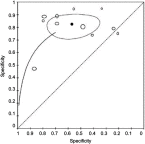The role of the Cincinnati Prehospital Stroke Scale in the emergency department: evidence from a systematic review and meta-analysis
- PMID: 31410071
- PMCID: PMC6646799
- DOI: 10.2147/OAEM.S178544
The role of the Cincinnati Prehospital Stroke Scale in the emergency department: evidence from a systematic review and meta-analysis
Abstract
Introduction: Stroke is one of the leading causes of morbidity, disability, and mortality in high-income countries. Early prehospital stroke recognition plays a fundamental role, because most clinical decisions should be made within the first hours after onset of symptoms. The Cincinnati Prehospital Stroke Scale (CPSS) is a validated screening tool whose utilization is suggested during triage. The aim of this study is to review the role of the CPSS by assessing its sensitivity and specificity in prehospital and hospital settings.
Methods: A systematic review and a meta-analysis of the literature reporting the CPSS sensitivity and specificity among patients suspected of stroke were undertaken. Electronic databases were searched up to December 2018, and the quality assessment was carried out by using the Revised Quality Assessment of Diagnostic Accuracy Studies -2 (QUADAS-2).
Results: Eleven studies were included in the meta-analysis. Results showed an overall sensitivity of 82.46% (95% confidence interval [CI] 74.83-88.09%) and specificity of 56.95% (95% CI 41.78-70.92). No significant differences were found in terms of sensitivity when CPSS was performed by physicians (80.11%, 95% CI 66.14-89.25%) or non-physicians (81.11%, 95% CI 69.78-88.87%). However, administration by physicians resulted in higher specificity (73.57%, 95% CI 65.78-80.12%) when compared to administration by non-physicians (50.07%, 95% CI 31.54-68.58%). Prospective studies showed higher specificity 71.61% (95% CI 61.12-80.18%) and sensitivity 86.82% (95% CI 74.72-93.63) when compared to retrospective studies which showed specificity of 33.37% (95% CI 22.79-45.94%) and sensitivity of 78.52% (95% CI 75.08-81.60).
Conclusions: The CPSS is a standardized and easy-to-use stroke screening tool whose implementation in emergency systems protocols, along with proper and consistent coordination with local, regional, and state agencies, medical authorities and local experts are suggested.
Keywords: diagnostic accuracy; emergency department; emergency medical services; healthcare; stroke; triage.
Conflict of interest statement
The authors report no conflicts of interest in this work.
Figures




References
-
- Setacci C, Lanza G, Ricci S, et al.; Stroke Prevention and Educational Awareness Diffusion (SPREAD). SPREAD Italian Guidelines for stroke. Indications for carotid endarterectomy and stenting. J Cardiovasc Surg (Torino). 2009;50(2):171–182. - PubMed
-
- GBD 2016 Disease and Injury Incidence and Prevalence Collaborators. Global, regional, and national incidence, prevalence, and years lived with disability for 328 diseases and injuries for 195 countries, 1990–2016: a systematic analysis for the Global Burden of Disease Study 2016. Lancet. 2017;390(10100):1211–1259. - PMC - PubMed
LinkOut - more resources
Full Text Sources

